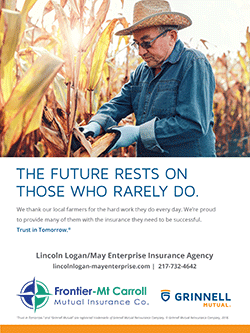|
 It is a wet spring, winter and fall, as you wait for the ground
to dry out and get ready to plant, please keep FSA in mind. If
you have rented a new farm, purchased a farm, or have changed
your operating structure, do not forget to get in touch with FSA
to report any changes. It is a wet spring, winter and fall, as you wait for the ground
to dry out and get ready to plant, please keep FSA in mind. If
you have rented a new farm, purchased a farm, or have changed
your operating structure, do not forget to get in touch with FSA
to report any changes.
Please take a look at your CRP contracts and check the contract
expiration dates. If you have mid management practices scheduled
on your CRP, make sure they are completed. Don't forget to check
the quality of the grain in your grain bins whether it is grain
that is under loan to FSA or not.
FSA has another request to you as a producer. With a spring
planting season that could be later than normal, do not forget
about reporting planted acres. As soon as you are finished
planting, please come into the FSA office sooner rather than
later to report your planted acres. Please do not wait until the
last minute. Do it early, so everyone can have the same great
level of service we provide to all our program participants.
I would also like to remind producers of the May 1, 2019,
deadline to certify their production for the Market Facilitation
Program benefits.
Thank you in advance.
William Graff

-----
Market Protection Program
Dairy producers who elected to participate in LGM-Dairy will be
eligible to retroactively sign up for 2018 MPP-Dairy coverage.
All other eligibility requirements must be met. This retroactive
sign up is exclusively for dairy producers with LGM coverage who
were producing and commercially marketing milk in 2018 but did
not obtain full year MPP-Dairy coverage. The signup deadline is
May 10, 2019.
There is a limited 2018 MPP-Dairy signup exclusively for dairy
operations who were producing and commercially marketing milk in
2018 but stopped commercially marketing milk before or during
the 2018 re-enrollment period. The 2018 re-enrollment period was
from April 9, 2018, through June 22, 2018. The Deputy
Administrator for Farm Programs (DAFP) has granted a blanket
relief for affected dairy operations to make MPP-Dairy coverage
elections for 2018. The signup deadline is May 10, 2019.
-----
Opportunity to Request a Referendum: Soybean Promotion,
Research, and Information Program
The USDA Agricultural Marketing Service (AMS) announced that
soybean producers may request a referendum on the Soybean
Promotion and Research Order, as authorized under the Soybean
Promotion, Research, and Consumer Information Act. Participation
in the Request for Referendum is voluntary, and producers should
only participate if they wish to request a referendum on the
program.
The results of the Request for Referendum will be published in a
notice in the Federal Register. If at least 10 percent of
eligible producers, as determined by USDA, participate in the
Request for Referendum, a referendum will be held within one
year from that determination.
Interested soybean producers may request a referendum during a
four-week period beginning on May 6 and ending May 31, 2019.
Form LS-51-1, Soybean Promotion and Research Order Request for
Referendum, may be downloaded online, or obtained by mail, fax,
or in person from Farm Service Agency (FSA) county offices
during this time.
Completed forms and supporting documentation must be returned to
the appropriate county FSA office by fax or in person no later
than close of business May 31, 2019, or if returned by mail,
must be postmarked by midnight May 31, 2019, and received in the
county FSA office by close of business on June 6, 2019.
For detailed information, including eligibility, read the full
AMS announcement. To find your local office, visit
www.farmers.gov.
----- Sign in/Sign up!
Farmers, ranchers and agricultural producers have new online
options to access U.S. Department of Agriculture (USDA)
programs. Through USDA’s new streamlined process, producers
doing business as an individual can now register, track and
manage their applications for the Market Facilitation Program (MFP)
on the secure and convenient www.farmers.gov. Producers doing
business as an individual first need to sign up for the Level 2
eAuthentication access. Currently USDA eAuthentication does not
have the mechanism to issue accounts to businesses,
corporations, other entities or for anyone acting on behalf of
another individual or entity.

Step 1: Create an online account at
www.eauth.usda.gov
Step 2: Complete identity verification by either using
the online self-service identity
Verification method or by completing the identity verification
in-person at your USDA Service Center.
Step 3: You’re enrolled
Step 4: Contact your local USDA Service Center to have
your new Level 2 account linked with your USDA customer record
Step 5: You’re ready to Log in
Or go to your local USDA Service Center and our support staff
will help you sign up for Level 2 Access right in the office!
They will get you online so you can create an online account at
https://farmers.gov/sign-in. You’ll complete identity
verification right on the spot. You’re enrolled! Users with a
secure Level 2 eAuthentication ID linked to their USDA customer
record can apply for select USDA programs, view and print farm
maps and farm records data. Enrolling is easy! Visit farmers.gov/sign-in
to learn more.
To locate a service center near you or use online services not
requiring eAuthentication access, visit
www.farmers.gov. For
technical assistance, call the eAuthentication help desk at
1-800-457-3642. -----
FSA Offers Joint Financing Option on Direct Farm Ownership
Loans
The USDA Farm Service Agency’s (FSA) Direct Farm Ownership loans
are a resource to help farmers and ranchers become
owner-operators of family farms, improve and expand current
operations, increase agricultural productivity, and assist with
land tenure to save farmland for future generations.
Depending on the applicant’s needs, there are three types of
Direct Farm Ownership Loans: regular, down payment and joint
financing. FSA also offers a Direct Farm Ownership Microloan
option for smaller financial needs up to $50,000.
Joint financing allows FSA to provide more farmers and ranchers
with access to capital. FSA lends up to 50 percent of the total
amount financed. A commercial lender, a State program or the
seller of the property being purchased, provides the balance of
loan funds, with or without an FSA guarantee. The maximum loan
amount for a Joint Financing loan is $300,000 and the repayment
period for the loan is up to 40 years.
To be eligible, the operation must be an eligible farm
enterprise. Farm Ownership loan funds cannot be used to finance
nonfarm enterprises and all applicants must be able to meet
general eligibility requirements. Loan applicants are also
required to have participated in the business operations of a
farm or ranch for at least three years out of the 10 years prior
to the date the application is submitted. The applicant must
show documentation that their participation in the business
operation of the farm or ranch was not solely as a laborer.
For more information about FSA Loan programs, contact your local
FSA office or visit www.fsa.usda.gov. To find your local FSA
office, visit http://offices.
usda.gov.
-----
Farm Storage Facility Loans
FSA’s Farm Storage Facility Loan (FSFL) program provides
low-interest financing to producers to build or upgrade storage
facilities and to purchase portable (new or used) structures,
equipment and storage and handling trucks.
The low-interest funds can be used to build or upgrade permanent
facilities to store commodities. Eligible commodities include
corn, grain sorghum, rice, soybeans, oats, peanuts, wheat,
barley, minor oilseeds harvested as whole grain, pulse crops
(lentils, chickpeas and dry peas), hay, honey, renewable
biomass, fruits, nuts and vegetables for cold storage
facilities, floriculture, hops, maple sap, rye, milk, cheese,
butter, yogurt, meat and poultry (unprocessed), eggs, and
aquaculture (excluding systems that maintain live animals
through uptake and discharge of water). Qualified facilities
include grain bins, hay barns and cold storage facilities for
eligible commodities.
Loans up to $100,000 can be secured by a promissory
note/security agreement. Loans exceeding $100,000 require
additional security.
Producers do not need to demonstrate the lack of commercial
credit availability to apply. The loans are designed to assist a
diverse range of farming operations, including small and
mid-sized businesses, new farmers, operations supplying local
food and farmers markets, non-traditional farm products, and
underserved producers.
[to top of second column] |

To learn more about the FSA Farm Storage Facility
Loan, visit
www.fsa.usda. gov/pricesupport or contact your local
FSA county office. To find your local FSA county office, visit
http://offices. usda.gov.
-----
Unauthorized Disposition of Grain
If loan grain has been disposed of through feeding, selling or
any other form of disposal without prior written authorization
from the county office staff, it is considered unauthorized
disposition. The financial penalties for unauthorized
dispositions are severe and a producer’s name will be placed on
a loan violation list for a two-year period. Always call before
you haul any grain under loan.
-----
Marketing Assistance Available for 2018 Crops
The 2014 Farm Bill authorized 2014-2018 crop year Marketing
Assistance Loans (MAL’s) and Loan Deficiency Payments (LDP’s).
MAL’s provide financing and marketing assistance for 2018 crop
feed grains, soybeans and other oilseeds, and pulse crops. MAL’s
provide producers interim financing after harvest to help them
meet cash flow needs without having to sell their commodities
when market prices are typically at harvest-time lows. The final
date to request a 2018 corn, soybean, or grain sorghum MAL is
May 31, 2019.
A producer who is eligible to obtain an MAL, but agrees to forgo
the loan, may obtain an LDP if such a payment is available.
To be eligible for an MAL or an LDP, producers must have a
beneficial interest in the commodity, in addition to other
requirements. A producer retains beneficial interest when
control of and title to the commodity is maintained. For an LDP,
the producer must retain beneficial interest in the commodity
from the time of planting through the date the producer filed
Form CCC-633EZ (page 1) in the FSA County Office. For more
information, producers should contact their local FSA county
office or view the LDP Fact Sheet.
-----
Maintaining the Quality of Farm-Stored Loan
Grain
Bins are ideally designed to hold a level volume of grain. When
bins are overfilled and grain is heaped up, airflow is hindered
and the chance of spoilage increases.
Producers who take out marketing assistance loans and use the
farm-stored grain as collateral should remember that they are
responsible for maintaining the quality of the grain through the
term of the loan.
-----
Actively Engaged Provisions for Non-Family
Joint Operations or Entities
Many Farm Service Agency programs require all program
participants, either individuals or legal entities, to be
“actively engaged in farming.” This means participants provide a
significant contribution to the farming operation, whether it is
capital, land, equipment, active personal labor and/or
management. For entities, each partner, stockholder or member
with an ownership interest, must contribute active personal
labor and/or management to the operation on a regular basis.

Joint operations comprised of non-family members or partners,
stockholders or persons with an ownership in the farming
operation must meet additional payment eligibility provisions.
Joint operations comprised of family members are exempt from
these additional requirements. For 2016 and subsequent crop
years, non-family joint operations can have one member that may
use a significant contribution of active personal management
exclusively to meet the requirements to be determined “actively
engaged in farming. ” The person or member will be defined as
the farm manager for the purposes of administering these
management provisions.
Non-family joint operations may request to add up to two
additional managers for their farming operation based on the
size and/or complexity of the operation. If additional farm
managers are requested and approved, all members who contribute
management are required to complete form CCC-902MR, Management
Activity Record. The farm manager should use the form to record
management activities including capital, labor and agronomics,
which includes crop selection, planting decisions, acquisition
of inputs, crop management and marketing decisions. One form
should be used for each month and the farm manager should enter
the number of hours of time spent for each activity under the
date of the month the actions were completed. The farm manager
must also document if each management activity was completed on
the farm or remotely.
The records and supporting business documentation must be
maintained and timely made available for review by the
appropriate FSA reviewing authority, if requested.
If the farm manager fails to meet these requirements, their
contribution of active personal management to the farming
operation for payment eligibility purposes will be disregarded
and their payment eligibility status will be re-determined for
the applicable program year.
In some instances, additional persons or members of a non-family
member joint operation who meet the definition of farm manager
may also be allowed to use such a contribution of active
personal management to meet the eligibility requirements.
However, under no circumstances may the number of farm managers
in a non-family joint operation exceed a total of three in any
given crop and program year.
More information on “Actively Engaged in Farming” can be found
online at
https://www.fsa.usda.gov/programs-and-services/payment-eligibility/actively
_engaged/index.
-----
Update Your Records
FSA is cleaning up our producer record database. If you have any
unreported changes of address, zip code, phone number, email
address or an incorrect name or business name on file they need
to be reported to our office. Changes in your farm operation,
like the addition of a farm by lease or purchase, need to be
reported to our office as well. Producers participating in FSA
and NRCS programs are required to timely report changes in their
farming operation to the County Committee in writing and update
their CCC-902 Farm Operating Plan.
If you have any updates or corrections, please call your local
FSA office to update your records.

-----
USDA Fruit, Vegetable and Wild Rice Planting
Rules Unchanged from Previous Farm Bill
Farm Service Agency (FSA) has announced fruit, vegetable and
wild rice provisions that affect producers who intend to
participate in certain programs authorized by the Agricultural
Act of 2014 as amended by the Agricultural Improvement Act of
2018.
Producers who intend to participate in the Agriculture Risk
Coverage (ARC) or Price Loss Coverage (PLC) programs are subject
to an acre-for-acre payment reduction when fruits and nuts,
vegetables or wild rice are planted on the payment acres of a
farm. Payment reductions do not apply to mung beans, dry peas,
lentils or chickpeas. Planting fruits, vegetables or wild rice
on acres that are not considered payment acres will not result
in a payment reduction. Farms that are eligible to participate
in ARC/PLC but are not enrolled for a particular year may plant
unlimited fruits, vegetables and wild rice for that year but
will not receive ARC/PLC payments for that year. Eligibility for
succeeding years is not affected.
Planting and harvesting fruits, vegetables and wild rice on
ARC/PLC acreage is subject to the acre-for-acre payment
reduction when those crops are planted on more than 15 percent
of the base acres of a farm enrolled in ARC using the county
coverage or PLC, or more than 35 percent of the base acres of a
farm enrolled in ARC using the individual coverage.
Fruits, vegetables and wild rice that are planted in a
double-cropping practice will not cause a payment reduction if
the farm is in a double-cropping region as designated by the
USDA’s Commodity Credit Corporation.
A fact sheet can be found online at:
https://www.fsa.usda.gov/Assets/USDA-FSA-Public/usdafiles/FactSheets/2017/arc
_plc_for_fav_and_wild_rice_may2017.pdf
April Interest Rates and
Important Dates

Illinois Farm Service Agency
3500 Wabash Ave.
Springfield, IL 62711
Phone: 217-241-6600
Fax: 855-800-1760
www.fsa.usda.gov/il
State Executive Director:
William J. Graff
State Committee:
James Reed-Chairperson
Melanie DeSutter-Member
Kirk Liefer-Member
George Obernagel-Member
Troy Uphoff-Member
To find contact information for your local office go to
www.fsa.usda.gov/il
|